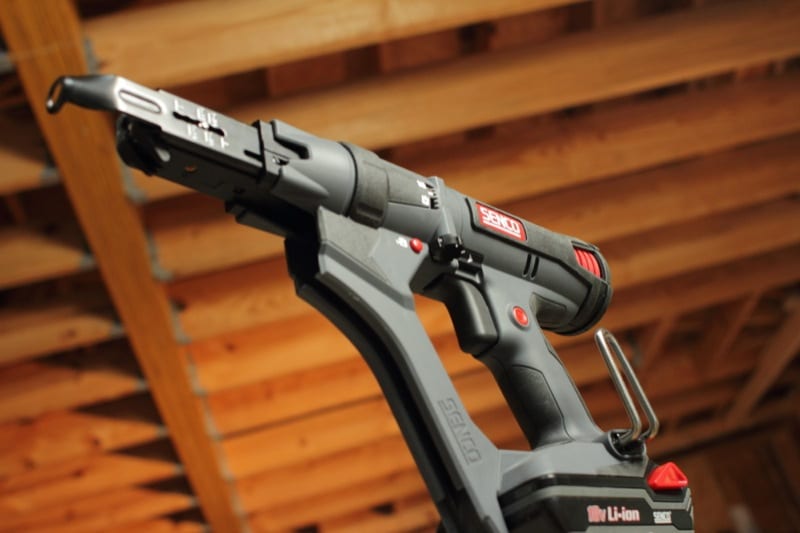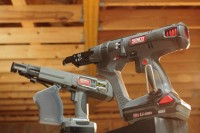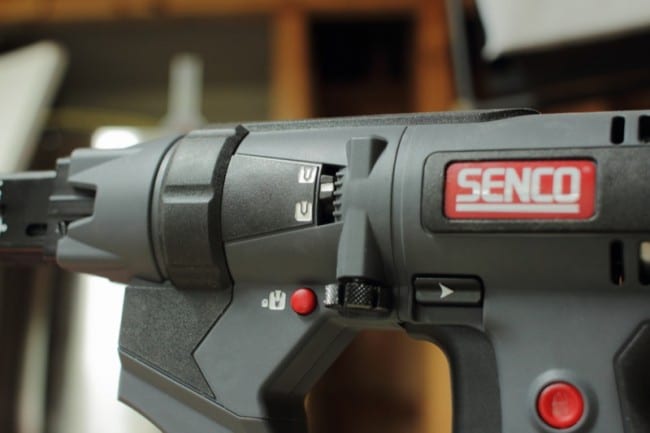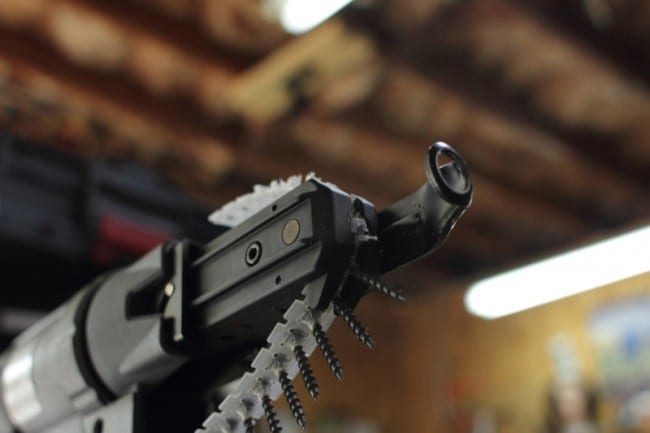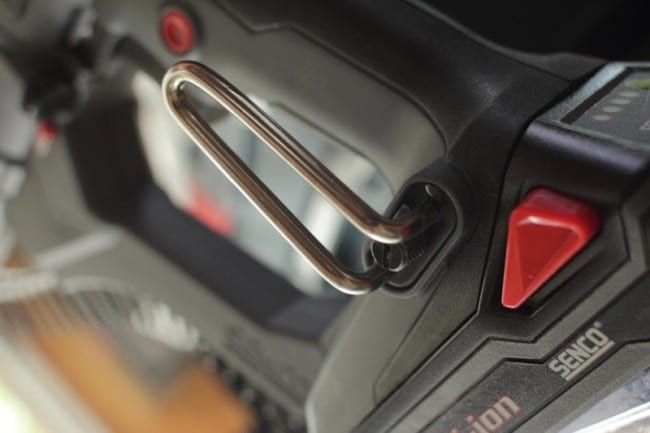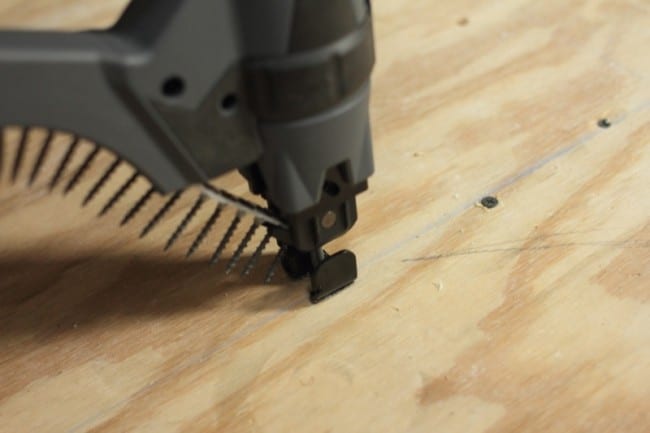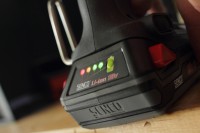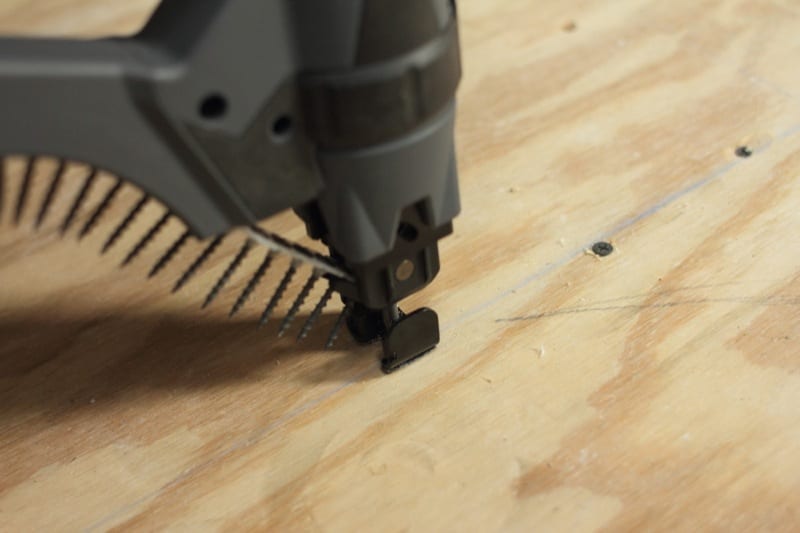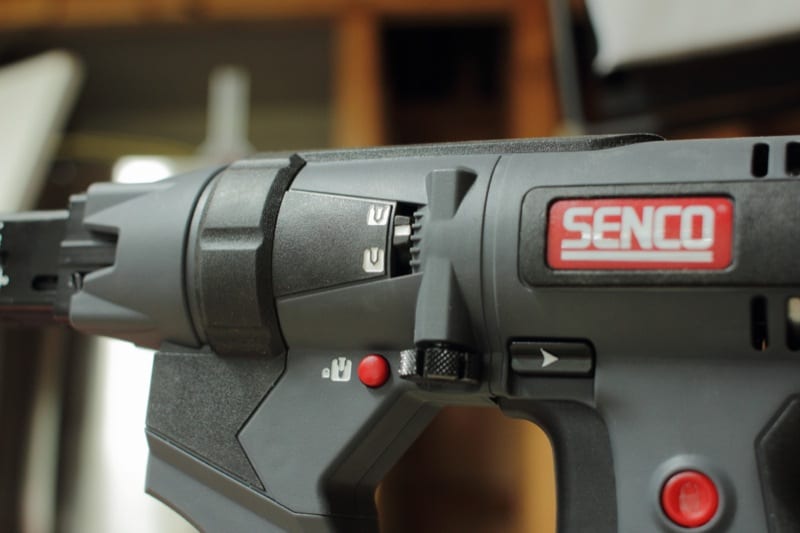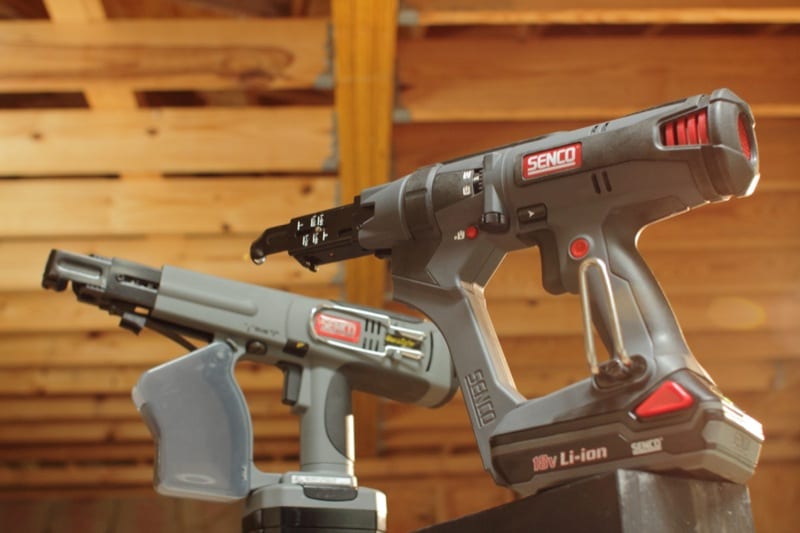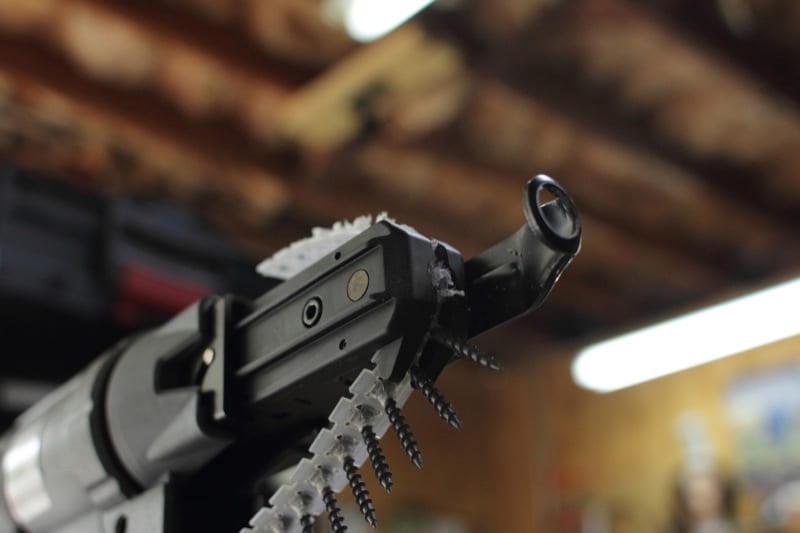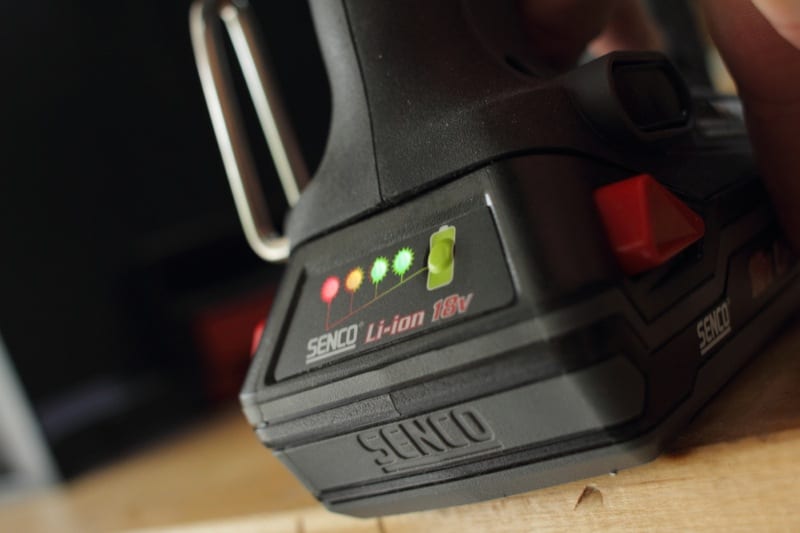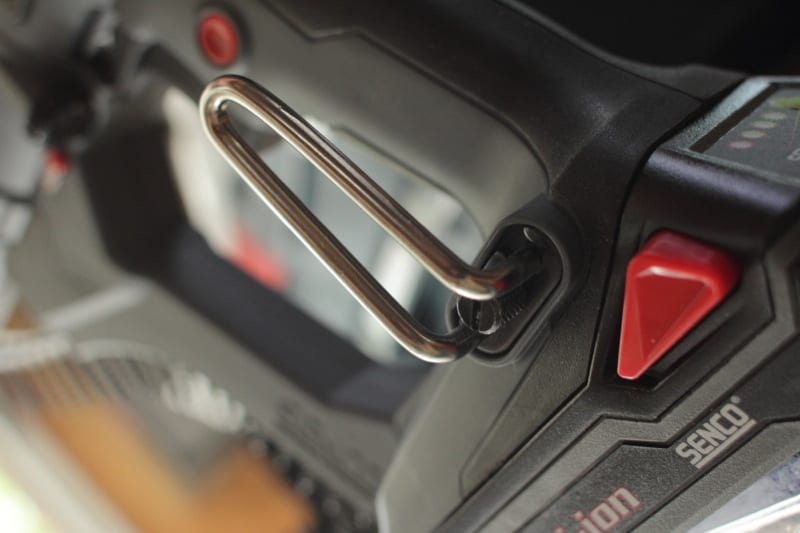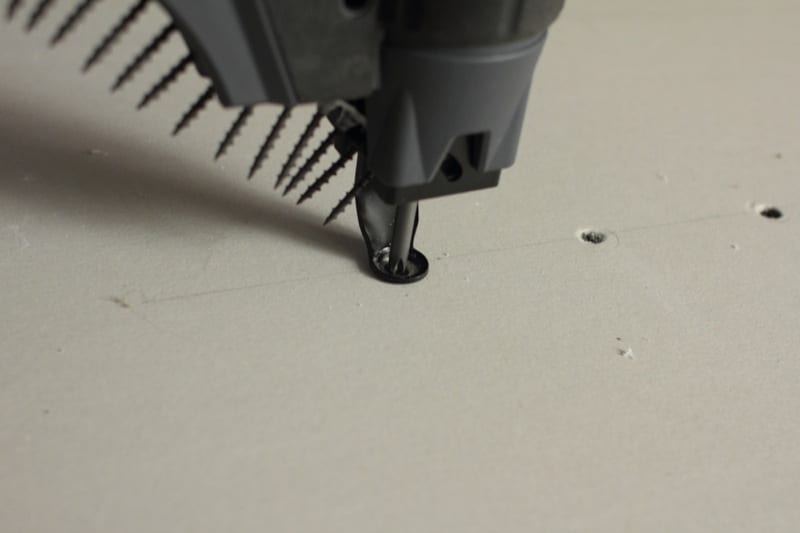Right out of the box, the Senco DS212-18V Auto-Feed Screwdriver looks more like a futuristic weapon than a screw gun. With sleeker lines, re-vamped and re-positioned controls and over a pound of excess weight vanished, this handy tool from Senco just got even handier. It also doesn’t require you to haul around Senco portable air compressors.
Designed to ease the installation of everything from plywood sheathing and subflooring to drywall and wall-coverings like T-111 (You can even install rigid foam insulation with this tool.), it’s a true jack of all trades.
While some would consider this a “gadgety” tool, it can be a real time- and work-saver in the right hands—especially if those hands are installing drywall on a ceiling all by themselves. Strips of collated screws used in the DS212-18V are readily available and average less than 2 cents per screw. (A bucket of 1000 costs just $17.82.) They’re pretty simple to install in the tool, with one caveat—I’ll get to that in a bit.
Comparing the New DS212-18V to the DS275-18V
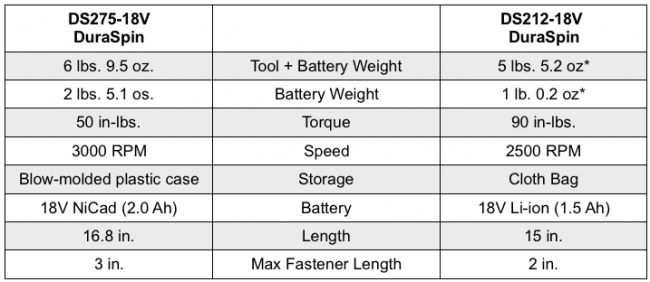
Senco DS212-18V Auto-Feed Screwdriver Features
The first thing I did when the Senco DS212-18V Auto-Feed Screwdriver arrived was compare it to one of its predecessors, the DS275-18V (which I’ve owned since 2002, according to the owner’s manual I found buried inside the bulky blow-molded case). It seems like only yesterday I was marveling at the way the elder Senco saved time and freed one hand on a job. I had only a few minor complaints about the original tool, and Senco apparently was listening because some of those irritants have been repaired.
First and foremost, the tool comes in weighing a whole pound and a half lighter—give or take a couple of ounces. This is solely thanks to a lighter lithium-ion battery. In fact, the bare tool actually weighs a little more than the older DS275-18V.
At the risk of sounding like Martha Stewart, the Senco DS212-18V Auto-Feed Screwdriver is easier on the hands and is a lot more streamlined with softer edges. Function seems to follow form in the updated model, and that’s a good thing.
Rubber overmold has been shifted here and there on the tool. It certainly helps prevent it from sliding around on a slope or from gouging delicate surfaces. Senco has also added something called a “Second Hand Grip” to the rear of the tool just behind the motor. It’s an area with slightly thicker rubber that provides a spot for additional pressure from your other hand. I say “other” hand and not “left” hand because this tool is completely ambidextrous. According to their literature, providing for a second grip point “helps combat worker fatigue”. I suppose that’s good news if you’re a combat worker. In all seriousness, during long runs of driving 2-inch screws, it could come in real handy…plus, it adds to the futuristic new look of the tool.
The Good
As mentioned above, several features have been improved right along with the facelift. In short, the Senco DS212-18V Auto-Feed Screwdriver has become a much easier tool to load and use. Gone is the bulky shield that surrounded the loaded fasteners. While it may have been of use to some, I always found it to be annoying and in the way. The newer design makes loading a strip of fasteners in the tool a quicker and much easier process.
According to an ancient proverb, “Your strength is your weakness.” This holds true for the older DuraSpin DS275-18V’s ability to adapt to different fastener lengths. While a great feature, it’s a rather time-consuming process and requires a hex key (one of my pet peeves—see my review of the DeWalt Cordless Framing Nailer in our April 2013 issue). There are days when I think any tool that requires a hex key should be tossed in the ocean—drastic, but an effective Dexter-style elimination of an irritant.
The good news is the DS212-18V requires only the push of a small button to change the nose piece position. This takes the process of switching fastener sizes from about a minute or so (if you can find the key) to less than 10 seconds with your thumbnail. The only thing Senco sacrificed was the ability to handle fasteners over 2 inches in length. (The DS275-18V could use screws up to 3 inches.) With a collated screwdriver I don’t see too many applications for serial 3-inch work.
Another vast improvement is the depth of drive adjustment. The Senco DS212-18V Auto-Feed Screwdriver uses a depth-sensing clutch to perfectly seat each screw, but you need to tell it where perfection lies. That has become a simple and precise operation with the push of a button and the micro-turn of a wheel. In the past, the adjustment came in quarter-turn increments, so there was less-precise control. Now you can really dial in your depth of drive. Drive bits are also easily changed at the slide of a button, and you can accommodate either Phillips or square-drive heads.
Job-specific nose pieces are also a big plus with this tool. The one designed for wood and other hard surfaces, is flat and has a sandpaper overlay to keep it in place. When installing drywall, you can switch to the nose piece made to perfectly dimple the paper surface. Both nose pieces are included in the kit and both work well for their individual tasks. Still, I tended to simply leave one nose piece on while I went to town on whatever project was at hand. You’ll understand why I have this mindset in a moment.
The addition of a variable-speed trigger gives you more precise control when it comes to seating the fasteners, although I tend to simply put the pedal to the metal and drive away. Again, this must be an old habit that refuses to die.
The new belt hook is a vast improvement as well. Now lower on the tool and with much more room to actually hang it, it becomes a useful feature that allows you to keep it handily hung at your side. Plus, it can be moved to either side of the tool. I think it’s indispensable when you’re working solo.
The Bad
While there have been welcome improvements over the older version, the Senco DS212-18V has still retained a couple of features that could stand a little…hope and change.
Swapping out the aforementioned nose piece is a bit of a nuisance. It requires the removal of a small set-screw that is just screaming to get dropped and lost on a cluttered job site floor. Once the screw is removed, the fastener-length adjustment button must be depressed and the nose piece slid out. Reverse the procedure with the other nose piece and voila—you’re done—the Good Lord willing and if the Creek don’t rise. A suggestion for Senco: at least include a spare set-screw for fumble-fingered people like me. You’re crippled for a good while if that screw goes AWOL.
Driving screws into tight corners remains a challenge with the DS212-18V Auto-feed Screwdriver. While the new, skinnier nose piece allows for a little extra wiggle room, I’ve always found that it’s easier to simply pull out my cordless drill/driver and slam 5 or 6 screws into the tight spots. No biggie, but worth noting—and you may find you have better luck.
I mentioned earlier that the strips were simple to install in the DS212-18V, but there’s a catch. After inserting them into the slide, you need to position the first screw just below the nose piece. Because the tool automatically advances the screw when depressed, if there is a screw in “firing” position, it can cause the mechanism to jam or misfire. The problem is, if you accidentally position the screw incorrectly, you can’t simply back it out. It has to be pulled the rest of the way through and re-inserted. This is another very minor annoyance, but it seems like it could be fixed in the design.
Specifications
- Item #: 7X0001N
- Battery: 18V Li-ion (1.5 Ah)
- Speed: 0-2500 RPM
- Torque: 90 in-lbs.
- Charger: 1 hour
- Tool Weight: 4.95 lbs.
- Height: 9.5 in.
- Length: 15 in.
- Width: 3.4 in.
- Fastener type: 1/2 in. – 2 in. #6-#10
- Fastener capacity: 50
- Drives per charge: 500-700
- Price: $273.99
The Bottom Line
While it takes a little getting used to, the Senco DS212 Auto-Feed Screwdriver has a lot going for it and is definitely a handy tool for anyone who tends to work alone. If you’ve never picked one up before, you should really give it a try. And though it may sound like I’ve dogged the tool some in this review, it’s purely out of love and a desire to see some minor potholes filled.
The updated lithium-ion batteries (the kit comes with two) let you be productive all day long with little to no down time waiting on a re-charge. And the added fuel indicator is a pleasant bonus.

